Preventative Biofouling Monitoring Technique for Sustainable Shipping
Abstract
1. Introduction
1.1. Preventing Biofouling on Ships
1.2. Other Issues Regarding Biofouling
1.3. Preventing Biofouling by Monitoring
1.4. Objective of Study
2. Methods and Procedure
2.1. Experiment System
2.1.1. Chasing Dory
2.1.2. Chasing M2
2.1.3. Observation Illuminance
2.2. Study Fishing Harbor and Fishing Vessels
2.2.1. Shenao Harbor
2.2.2. Monitoring Vessels
3. Results
3.1. Optimal Distance Measurement
3.2. Comparison of Monitoring Functions
3.3. Optimal Shooting Parameters
3.3.1. Relationship between Illuminance and Depth
3.3.2. Underwater Image
3.3.3. Before and after Cleaning
4. Discussion
4.1. Reasons for Underwater Monitoring
4.2. Performance of Underwater Cameras
- The imaging measurements are fast and accurate;
- The image itself is valuable visual data;
- Multiple measurements can be made with the same image;
- The imagery can automatically save metadata such as geographic location, date, and time;
- The images and measurement data can be archived electronically.
4.3. Environmental and Economic Benefit of Using Developed System
5. Conclusions
Author Contributions
Funding
Conflicts of Interest
References
- Townsin, R.L. The Ship Hull Fouling Penalty. J. Bioadhesion Biofilm Res. 2003, 19, 9–15. [Google Scholar] [CrossRef] [PubMed]
- Wang, H.; Oguz, E.; Jeong, B.; Zhou, P. Life cycle cost and environmental impact analysis of ship hull maintenance strategies for a short route hybrid ferry. Ocean Eng. 2018, 161, 20–28. [Google Scholar] [CrossRef]
- Watanabe, S.; Nagamatsu, N.; Yokoo, K.; Kawakami, Y. The augmentation in frictional resistance due to slime. J. Kansai Soc. Nav. Archit. 1969, 131, 45–51. [Google Scholar] [CrossRef] [PubMed]
- The International Maritime Organization. UN Body Adopts Climate Change Strategy for Shipping. Press Briefing, MarineLink. 13 April 2018. Available online: https://www.marinelink.com/news/strategy-shipping-climate436339 (accessed on 1 March 2023).
- Wu, Y.; Hua, J.; Wu, D.L. Economic analysis of ship operation using a new antifouling strategy. Ocean Eng. 2022, 266, 13038. [Google Scholar] [CrossRef]
- Cheng, C.W.; Hua, J.; Hwang, D. NOx emission calculations for bulk carriers by using engine power probabilities as weighting factors. J. Air Waste Manag. Assoc. 2017, 67, 1146–1157. [Google Scholar] [CrossRef]
- Davidson, I.C.; Brown, C.W.; Sytsma, M.D.; Ruiz, G.M. The role of containerships as transfer mechanisms of marine biofouling species. Biofouling 2019, 25, 645–655. [Google Scholar] [CrossRef]
- Farkas, A.; Degiuli, N.; Martić, I. Assessment of the effect of biofilm on the ship hydrodynamic performance by performance prediction method. Int. J. Nav. Archit. Ocean Eng. 2021, 13, 102–114. [Google Scholar] [CrossRef]
- Krapp, A.; Vranakis, G. A Practical Way to Evaluate the Inservice Performance of Antifouling Coatings. In Proceedings of the SNAME, Athens, Greece, December 2013. [Google Scholar]
- Ballegooijen, E.; Muntean, T. Fuel saving potentials via measuring propeller thrust and hull resistance at full scale: Experience with ships in service. In Proceedings of the HULLPIC, Castello di Pavone, Italy, April 2016. [Google Scholar]
- Schultz, M.P.; Bendick, J.A.; Holm, E.R.; Hertel, W.M. Economic impact of biofouling on a naval surface ship. Biofouling 2011, 27, 87–98. [Google Scholar] [CrossRef]
- Song, S.; Kemal, Y.; Atlar, D.M. An investigation into the effect of biofouling on the ship hydrodynamic characteristics using CFD. Ocean Eng. 2019, 175, 122–137. [Google Scholar] [CrossRef]
- Farkas, A.; Song, S.; Degiuli, N.; Martić, I.; Demirel, Y.K. Impact of biofilm on the ship propulsion characteristics and the speed reduction. Ocean Eng. 2020, 199, 107033. [Google Scholar] [CrossRef]
- BBC News. Available online: https://www.bbc.com/news/world-australia-64138743 (accessed on 1 March 2023).
- Marine Biosecurity Porthole. Biofouling Management of International Vessels. Available online: https://marinebiosecurity.niwa.co.nz/biofouling-management-of-international-vessels/ (accessed on 1 March 2023).
- Munk, T.; Yebra, D.M. Advances in Marine Antifouling Coatings and Technologies. Available online: https://www.sciencedirect.com/topics/engineering/marine-biofouling (accessed on 11 March 2021).
- ANZECC. Code of Practice for Antifouling and In-Water Cleaning and Maintenance. Prepared by the Australian and New Zealand Environment and Conservation Council (Maritime Accidents and Pollution Implementation Group), Canberra, Australia. 2020. Available online: http://www.environment.gov.au/coasts/pollution/antifouling/code/pubs/code.pdf (accessed on 24 April 2020).
- Oliveira, D.; Granhag, L. Matching forces applied in underwater hull cleaning with adhesion strength of marine organisms. J. Mar. Sci. Eng. 2016, 4, 66. [Google Scholar] [CrossRef]
- Hopkins, G.; Forrest, B.; Coutts, A. Determining the Efficacy of Incursion Response Tools: Rotating Brush Technology (Coupled with Suction Capability). MAF Biosecurity N. Z. Tech. 2009/39. Available online: https://niwa.co.nz/static/marine-biosecurity/marine-response-tools-rotating-brushes.pdf (accessed on 2 April 2022).
- Yebra, D.M.; Kiil, S. Antifouling technology—Past, present and future steps towards efficient and environmentally friendly antifouling coatings. Prog. Org. Coat. 2004, 50, 75–104. [Google Scholar] [CrossRef]
- Kinnaman, B. The Future: Autonomous Robotic Hull Grooming. Available online: https://www.marinelink.com/news/future-autonomous-robotic-hull-grooming-464099 (accessed on 11 March 2021).
- Song, S.; Demirel, Y.K.; Atlar, M.; Dai, S.; Day, S.; Turan, O. Validation of the CFD approach for modelling roughness effect on ship resistance. Ocean Eng. 2020, 200, 107029. [Google Scholar] [CrossRef]
- Hua, J.; Chiu, Y.S.; Tsai, C.Y. En-route operated hydroblasting system for counteracting biofouling on ship hull. Ocean Eng. 2018, 152, 249–256. [Google Scholar] [CrossRef]
- Anderson, C.D.; Hunter, J.E. Whither antifoulings after TBT? In Proceedings of the NAV 2000 International Conference on Ship and Shipping Research, 13th Congress Paper 3.7, Venice, Italy, 19–22 September 2000. [Google Scholar]
- Edyvean, R. Consequences of fouling on shipping. In Biofouling; Wiley-Blackwell: Oxford, UK, 2010; pp. 217–225. [Google Scholar]
- Brooks, S.; Waldock, M. The use of copper as a biocide in marine antifouling paints. In Advances in Marine Antifouling Coatings and Technologies; Woodhead Publishing: Oxford, UK, 2009. [Google Scholar]
- Legg, M.; Yücel, M.K.; Garcia de Carellan, I.; Kappatos, V.; Selcuk, C.; Gan, T.H. Acoustic methods for biofouling control: A review. Ocean Eng. 2015, 103, 237–247. [Google Scholar] [CrossRef]
- Thomas, K.V.; Brooks, S. The environmental fate and effects of antifouling paint biocides. Biofouling 2010, 26, 73–88. [Google Scholar] [CrossRef]
- Davidson, I.C.; McCann, L.D.; Sytsma, M.D.; Ruiz, G.M. Interrupting a multispecies bioinvasion vector: The efficacy of in-water cleaning for removing biofouling on obsolete vessels. Mar. Pollut. Bull. 2008, 56, 1538–1544. [Google Scholar] [CrossRef]
- Floerl, O.; Smith, M.; Inglis, G.; Davey, N.; Seaward, K.; Johnston, O.; Fitridge, I.; Rush, N.; Middleton, C.; Coutts, A. Vessel Biofouling as a Vector for the Introduction of Non-Indigenous Marine Species to New Zealand: Recreational Yachts; Research Project ZBS2004-03A; NIWA Client Report prepared for MAF Biosecurity New Zealand, Ministry of Agriculture and Forestry: Wellington, New Zealand, 2010.
- Caccia, M.; Veruggio, G. Modeling and identification of open-frame variable configuration unmanned vehicles. IEEE J. Ocean Eng. 2000, 25, 227–240. [Google Scholar] [CrossRef]
- Zhao, C.; Thies, P.R.; Johanning, L. Offshore inspection mission modelling for an ASV/ROV system. Ocean Eng. 2022, 259, 111899. [Google Scholar] [CrossRef]
- Hover, F.S.; Grosenbaugh, M.A.; Triantafyllou, M.S. Calculation of Dynamic Motions and Tensions in Towed Underwater Cables. IEEE J. Ocean Eng. 1990, 19, 449–457. [Google Scholar] [CrossRef]
- Shinsuke, A. Simple Imaging Techniques for Plant Growth Assessment. Available online: https://edis.ifas.ufl.edu/publication/HS1353 (accessed on 17 April 2022).
- Adland, R.; Cariou, P.; Jia, H.; Wolff, F.C. The energy efficiency effects of periodic ship hull cleaning. J. Clean. Prod. 2018, 178, 1–13. [Google Scholar] [CrossRef]
- Logan, K.P. Using a ship’s propeller for hull condition monitoring. Nav. Eng. J. 2012, 124, 71–87. [Google Scholar]
- Pérez, M.C.; Mårtensson, L. Organic alternatives to copper in the control of marine biofouling. In Advances in Marine Antifouling Coatings and Technologies; Woodhead Publishing: Oxford, UK, 2009. [Google Scholar]
- Scianni, C.; Georgiades, E. Vessel In-Water Cleaning or Treatment: Identification of Environmental Risks and Science Needs for Evidence-Based Decision Making. Available online: https://www.frontiersin.org/articles/10.3389/fmars.2019.00467/full (accessed on 17 March 2020).
- IliyaValchev, I.; Coraddu, A.; Kalikatzarakis, M.; Geertsma, R.; Oneto, L. Numerical methods for monitoring and evaluating the biofouling state and effects on vessels’ hull and propeller performance: A review. Ocean Eng. 2020, 251, 110883. [Google Scholar] [CrossRef]
- Eartheasy. Eco-Friendly Boating. Available online: https://learn.eartheasy.com/guides/eco-friendly-boating/ (accessed on 20 November 2021).
- Uzun, D.; Demirel, Y.K.; Coraddu, A.; Turan, O. Time-dependent biofouling growth model for predicting the effects of biofouling on ship resistance and powering. Ocean Eng. 2019, 191, 106432. [Google Scholar] [CrossRef]
- Abbott, A.; Abel, P.D.; Arnold, D.W.; Milne, A. Cost-benefit analysis of the use of TBT: The case for a treatment approach. Sci. Tot. Environ. 2000, 258, 5–19. [Google Scholar] [CrossRef] [PubMed]
- Townsin, R.L.; Byrne, D.; Svensen, T.E.; Milne, A. Estimating the technical and economic penalties of hull and propeller roughness. Trans. SNAME 1981, 89, 295–318. [Google Scholar]
- Townsin, R.L.; Spencer, D.S.; Mosaad, M.; Patience, G. Rough propeller penalties. Trans. SNAME 1985, 93, 165–187. [Google Scholar]
- UNFCCC. What Is the Kyoto Protocol? Available online: https://unfccc.int/kyoto_protocol (accessed on 17 November 2021).
- Balcombe, P.; Brierley, J.; Lewis, C.; Skatvedt, L.; Speirs, J.; Hawkes, A.; Staffell, I. How to decarbonise international shipping: Options for fuels, technologies, and policies. Energy Convers. Manag. 2019, 182, 72–88. [Google Scholar] [CrossRef]
- Tamburri, M.N.; Davidson, I.C.; First, M.R.; Newcomer, K.; Inglis, G.J.; Georgiades, E.T.; Barnes, J.M.; Ruiz, G.M. In-water cleaning and capture to remove ship biofouling: An initial evaluation of efficacy and environmental safety. Front. Mar. Sci. 2020, 7. [Google Scholar] [CrossRef]

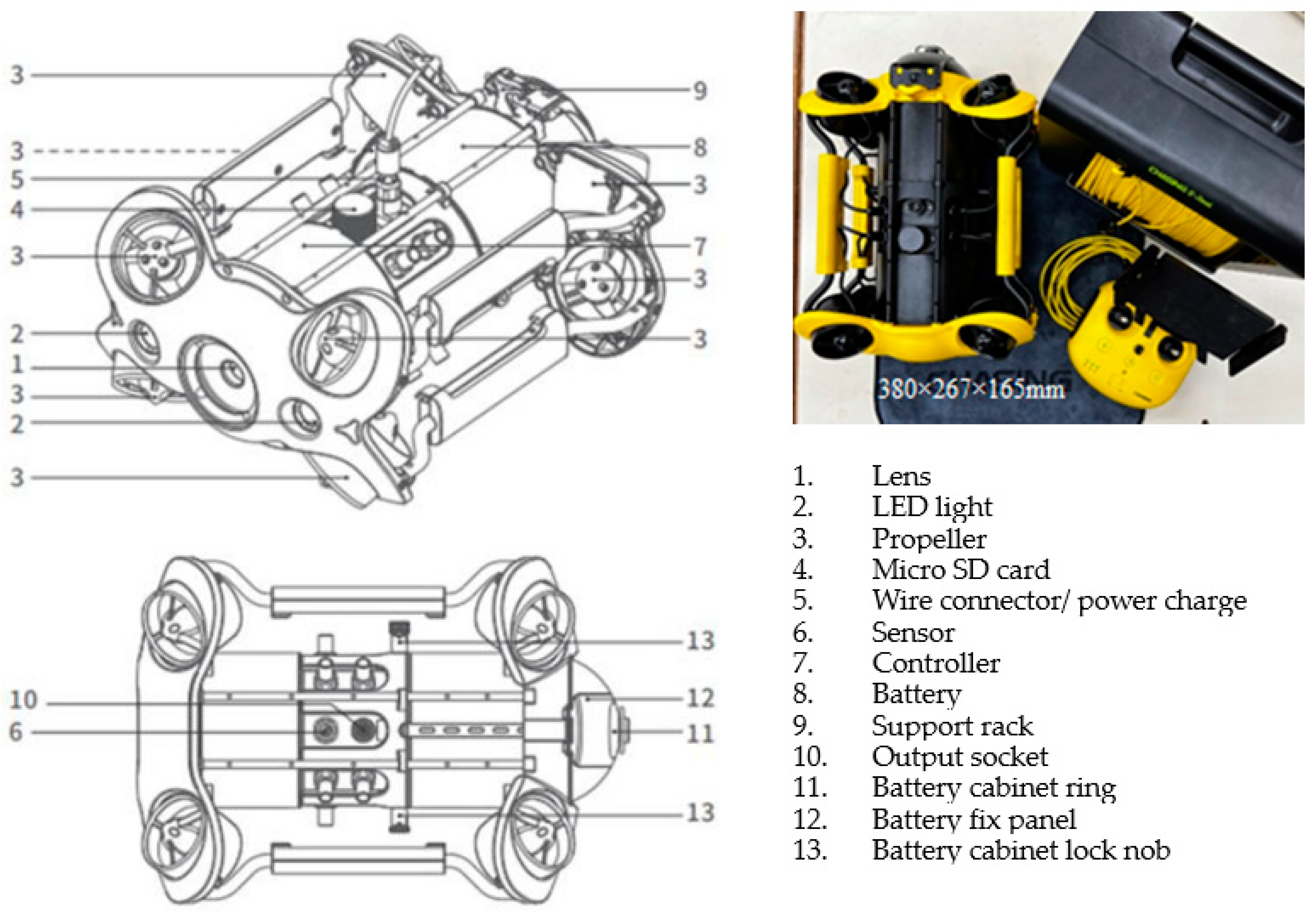
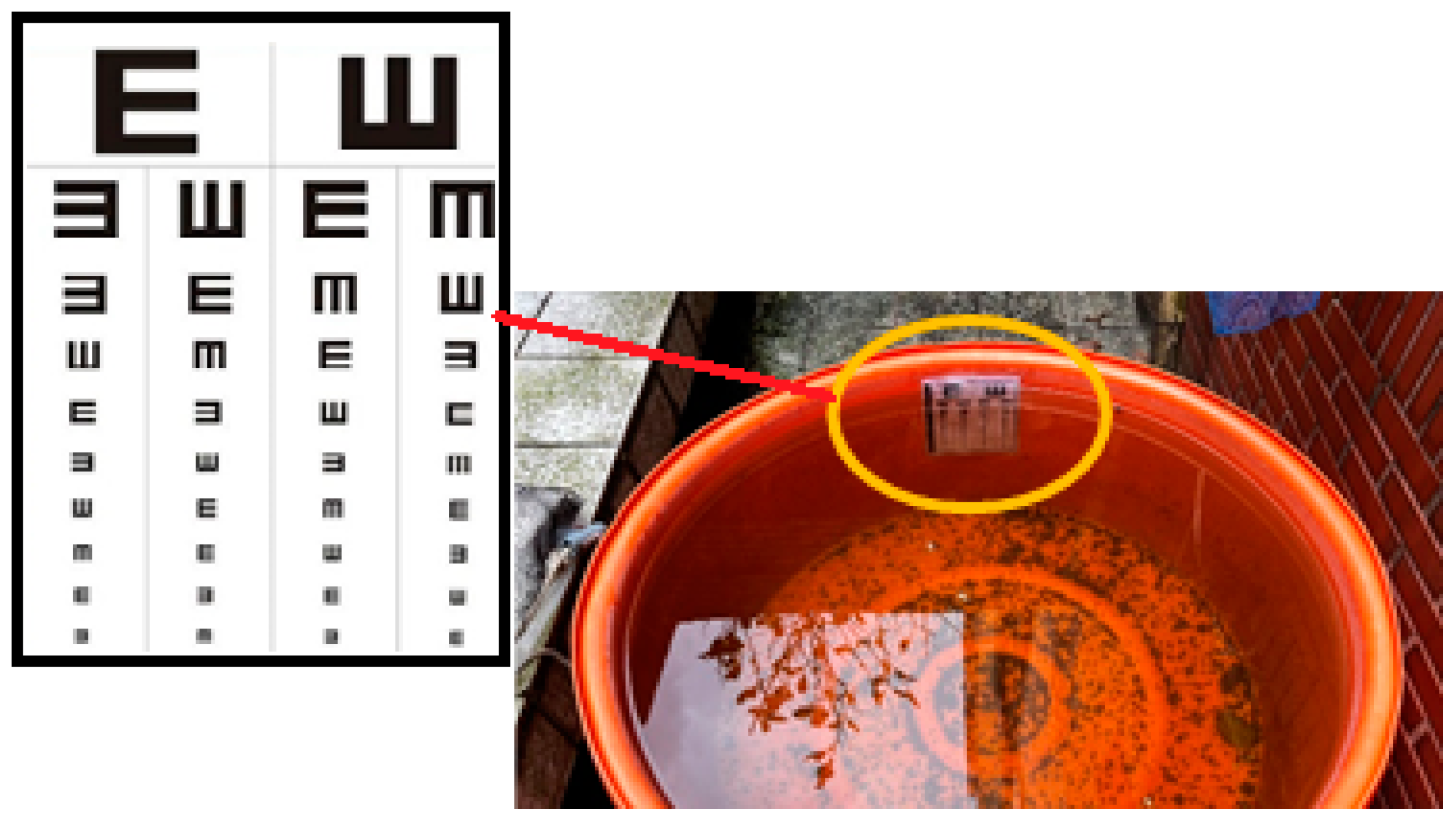
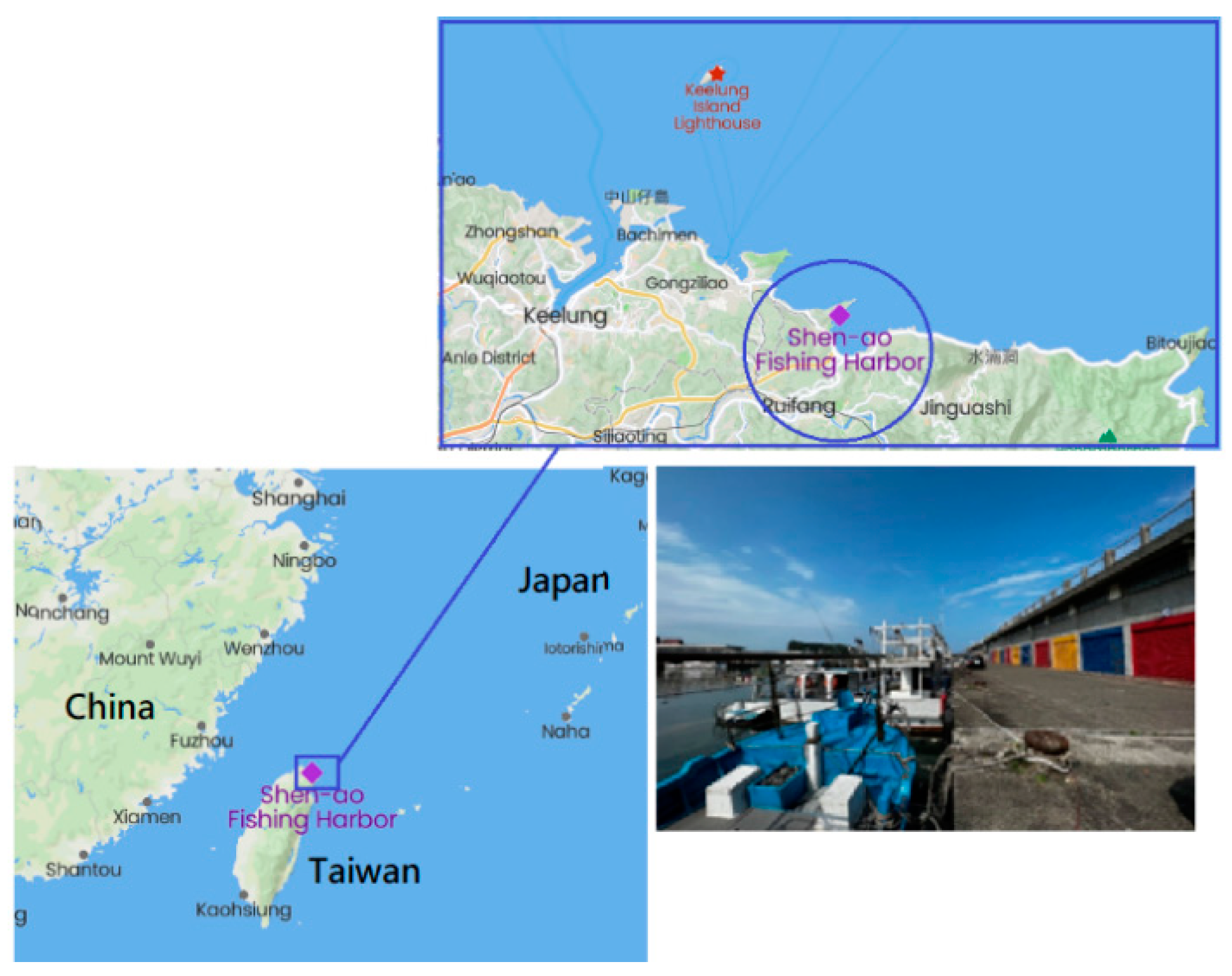
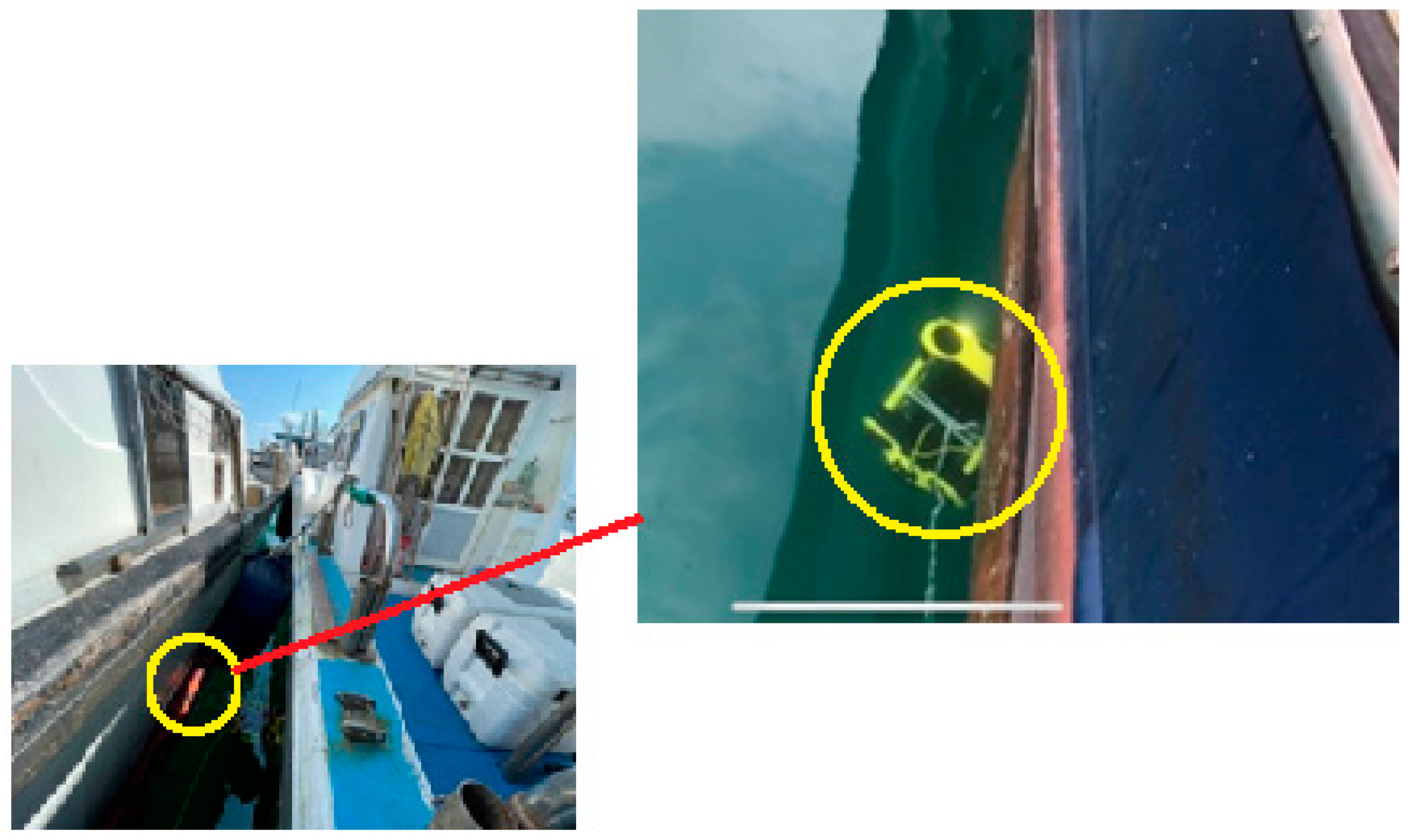
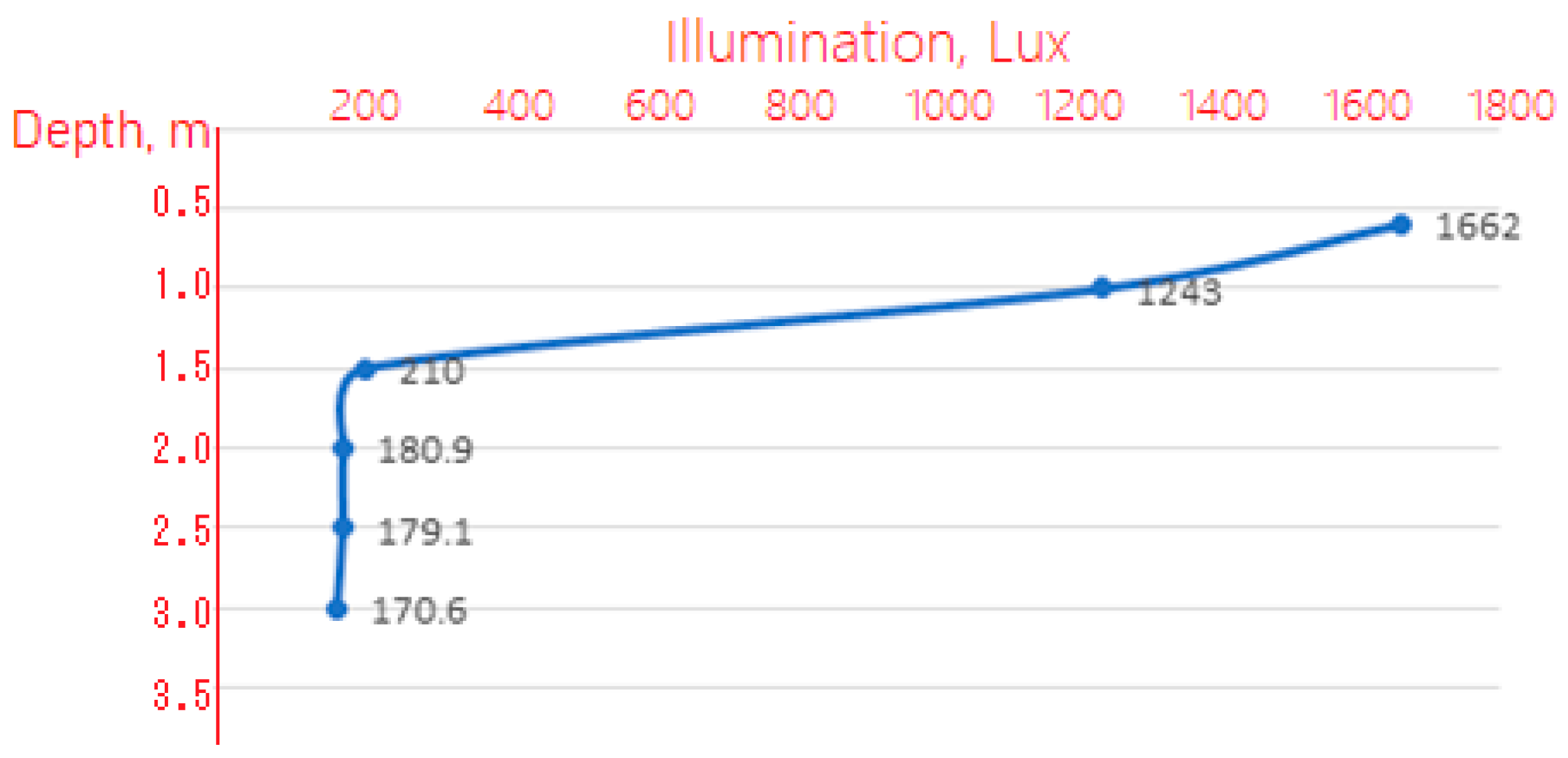
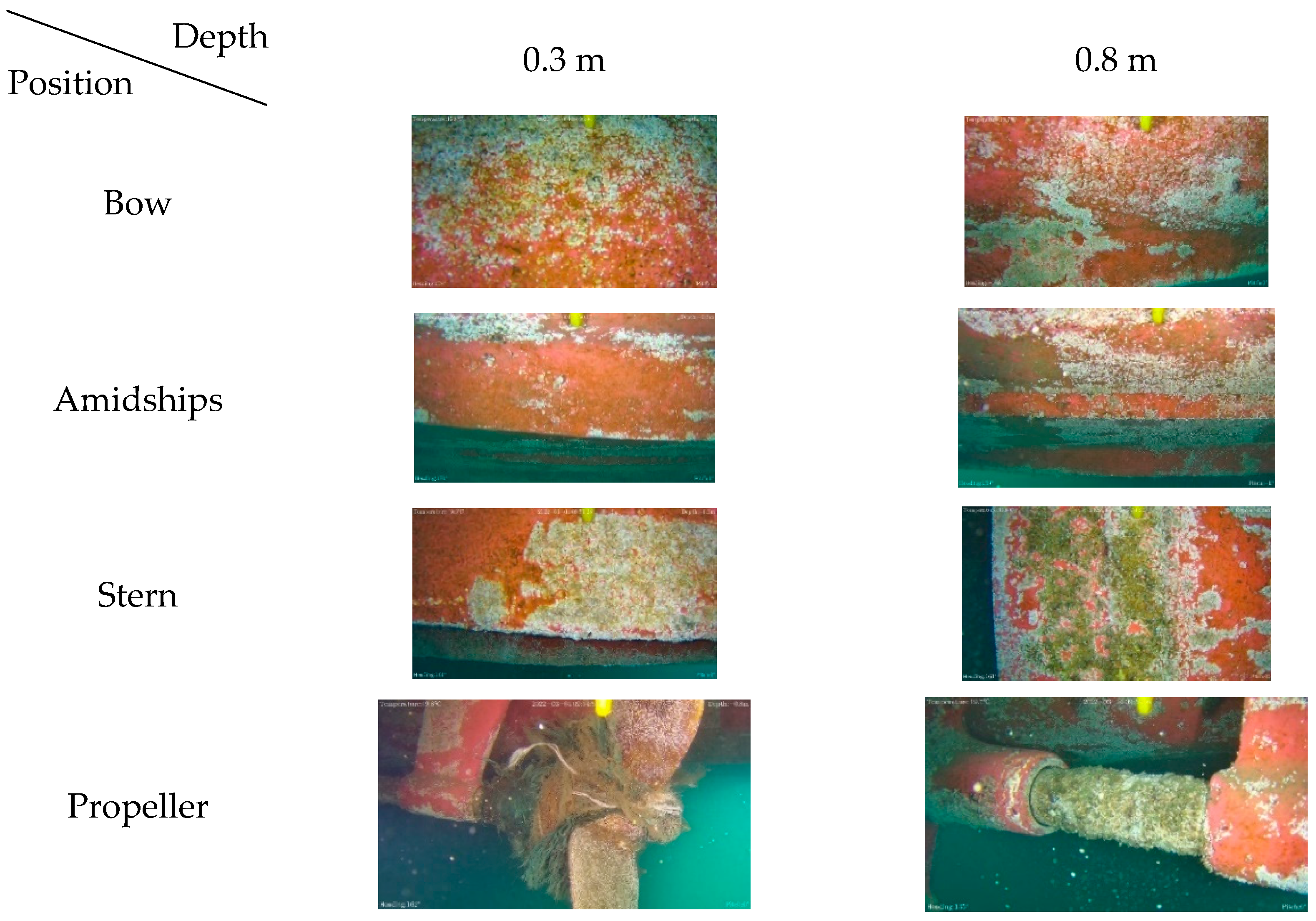
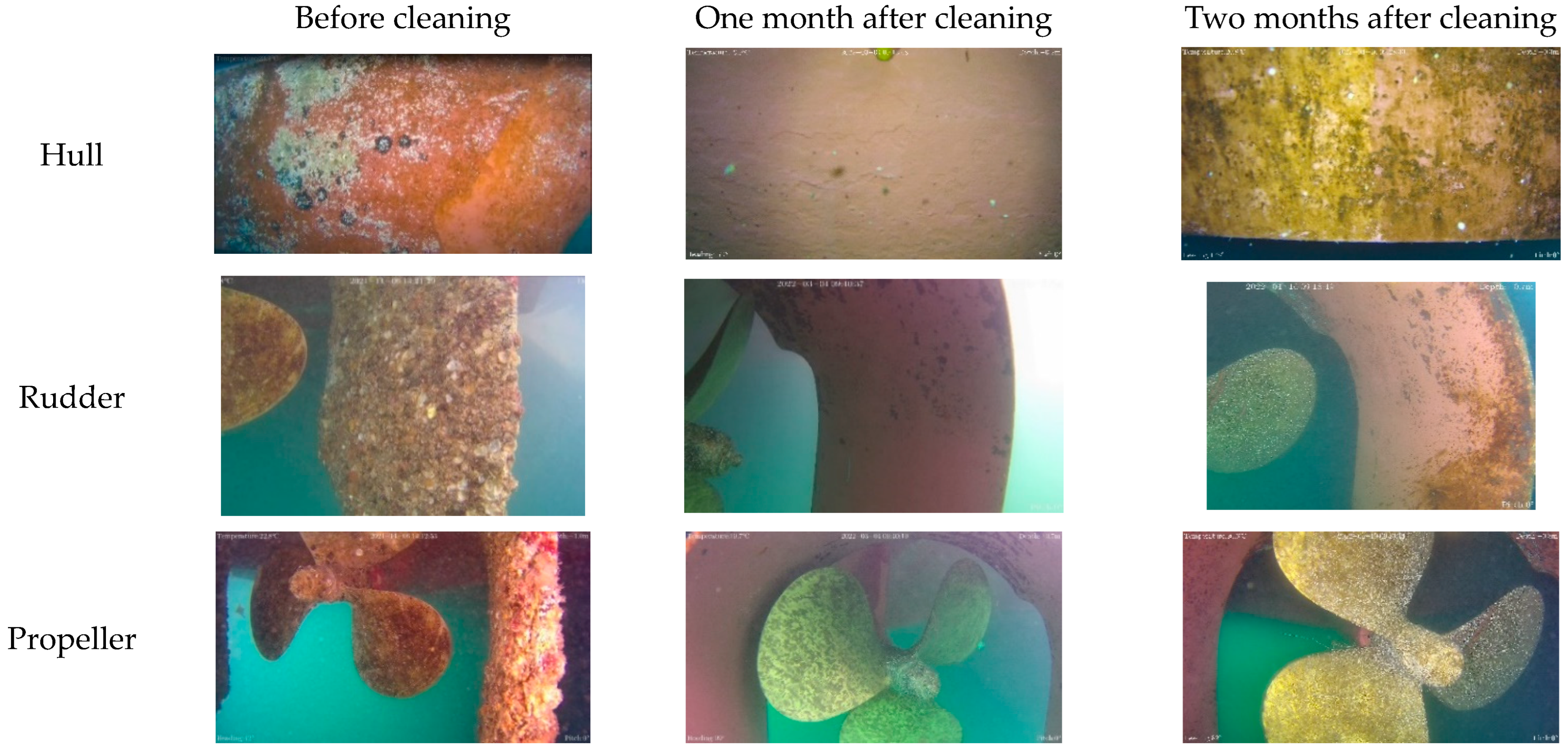

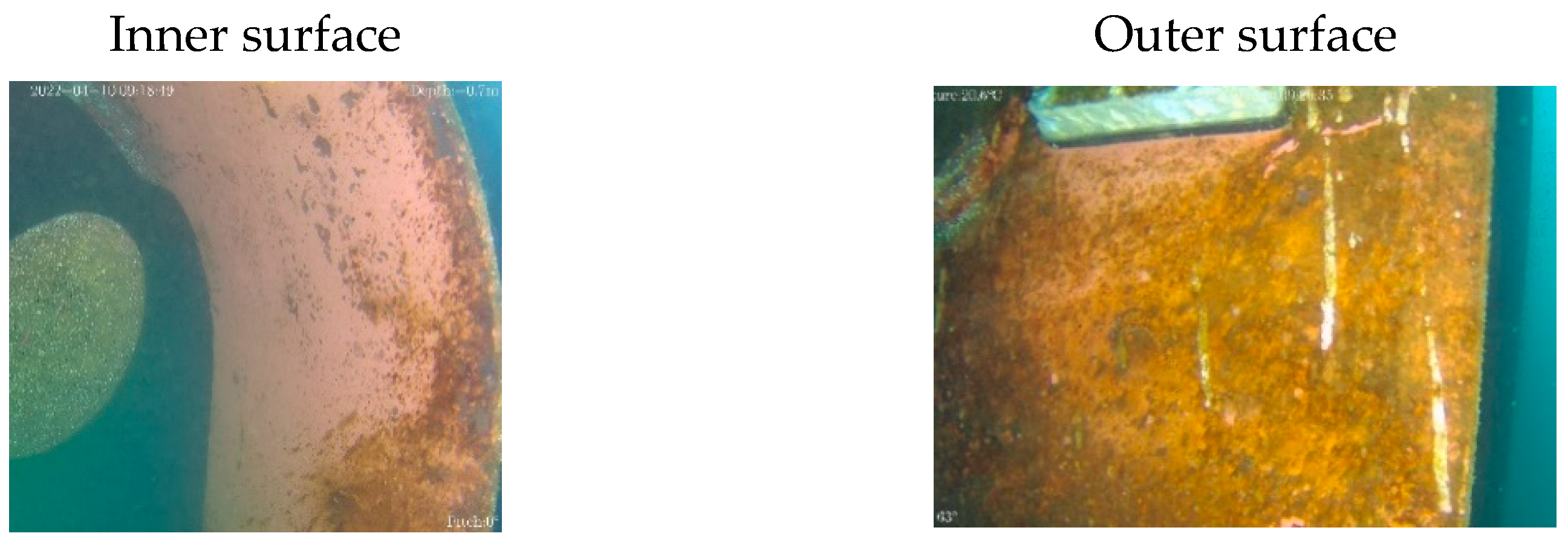
| Robot | Chasing Dory | Chasing M2 |
|---|---|---|
| Size, mm | 247 × 188 × 92 | 380 × 267 × 165 |
| Weight, kg | 1.1 | 4.5 |
| Maximum depth, m | 15 | 100 |
| Maximum speed, knot | 1.5 | 3 |
| Camera lens | F/1.6 | F/1.8 |
| Camera focus, mm | 4 | 1 |
| ISO range | 100–3200 | 100–6400 |
| FOV | 100° | 152° |
| Max. resolution | 2 M | 12 M |
| IMU | 3-axis gyroscope, accelerator, compass | 3-axis gyroscope, accelerator, compass |
| Depth transmitter | ≤±0.5 m | ≤±0.25 m |
| Temperature transmitter | ≤±2 °C | ≤±2 °C |
| Size, mm | 56 × 36 × 195 |
| Weight, g | 270 |
| Range of measurement, Lux | 0–200,000 |
| Temperature range of measuring, °C | −9.9–49.9 |
| Working temperature, °C | 0–40 |
| Vessel | Vessel #1 | Vessel #2 |
|---|---|---|
| Gross tonnage | 9.96 | 8.29 |
| Net tonnage | 2.99 | 2.49 |
| Length overall, m | 14.73 | 11.95 |
| Breadth midship, m | 3.23 | 3.12 |
| Depth midship, m | 1.41 | 0.9 |
| Maximum draft, m | 1.2 | 0.5 |
| Fuel capacity, l | 1600 | 1400 |
| Rate speed, knots | 11 | 10 |
| Chasing Dory | Chasing M2 | |||
|---|---|---|---|---|
| Distance | Daylight Only | Supplementary Light | Daylight Only | Supplementary Light |
| 10 cm |  |  |  |  |
| 20 cm |  |  |  |  |
| 30 cm |  |  |  |  |
| 40 cm |  |  |  |  |
| 50 cm |  |  |  |  |
Disclaimer/Publisher’s Note: The statements, opinions and data contained in all publications are solely those of the individual author(s) and contributor(s) and not of MDPI and/or the editor(s). MDPI and/or the editor(s) disclaim responsibility for any injury to people or property resulting from any ideas, methods, instructions or products referred to in the content. |
© 2023 by the authors. Licensee MDPI, Basel, Switzerland. This article is an open access article distributed under the terms and conditions of the Creative Commons Attribution (CC BY) license (https://creativecommons.org/licenses/by/4.0/).
Share and Cite
Wu, D.; Hua, J.; Chuang, S.-Y.; Li, J. Preventative Biofouling Monitoring Technique for Sustainable Shipping. Sustainability 2023, 15, 6260. https://doi.org/10.3390/su15076260
Wu D, Hua J, Chuang S-Y, Li J. Preventative Biofouling Monitoring Technique for Sustainable Shipping. Sustainability. 2023; 15(7):6260. https://doi.org/10.3390/su15076260
Chicago/Turabian StyleWu, Dalian, Jian Hua, Shun-Yao Chuang, and Junseng Li. 2023. "Preventative Biofouling Monitoring Technique for Sustainable Shipping" Sustainability 15, no. 7: 6260. https://doi.org/10.3390/su15076260
APA StyleWu, D., Hua, J., Chuang, S.-Y., & Li, J. (2023). Preventative Biofouling Monitoring Technique for Sustainable Shipping. Sustainability, 15(7), 6260. https://doi.org/10.3390/su15076260





